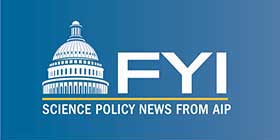The 2018 Midterm Elections: Outlook for Science Policy
By William Thomas
Although the results of the US midterm election are now mostly known, their implications for science policy will only unfold with time. Some of the most immediate changes will occur in the committees of the House of Representatives, where on January 3 the Democrats will take power for the first time in eight years.

The predominant forum for science policy debate and legislation in the House is the Committee on Science, Space, and Technology. Eddie Bernice Johnson (D-TX) is expected to become committee chair, having served as its top Democrat since 2010. She has already identified a number of specific priorities for the coming Congress such as engaging underrepresented groups and blue-collar workers in STEM fields, guarding science from “political attacks,” and challenging “misguided or harmful” actions by the Trump administration.
Over the past several years, the Science Committee has often been embroiled in controversy, particularly on occasions when its Republican leadership used it as a platform for challenging mainstream climate science. Johnson states she would like not only to address climate change, but also “restore the credibility of the Science Committee as a place where science is respected and recognized as a crucial input to good policymaking.”
Climate change is apt to be a significant focus beyond the Science Committee as well. It and two other committees are already planning two days of hearings on the subject in early 2019. Current House Minority Leader Nancy Pelosi (D-CA) has also suggested reinstating a special committee on climate change that the Republicans disbanded in 2011, though not all Democrats believe such a move is necessary.
Meanwhile, nearly half the 45 Republicans in the Climate Solutions Caucus, including co-chair Representative Carlos Curbelo (R-FL), are departing due to retirements and election defeats. Although the caucus has taken few concrete actions since its establishment in 2016, by admitting members only in bipartisan pairs it has spotlighted the existence of interparty interest in a subject that has been a persistent source of partisan conflict.
Below the radar, there will likely be some continuity in advancing legislation. In recent years, most of the science policy bills that have made headway in both the House and Senate have been bipartisan ones. During the current Congress, major bills setting policy for NASA, the Department of Energy Office of Science, and weather forecasting research have been signed into law. In addition, legislation to establish a National Quantum Initiative currently has significant momentum.
A point of particular interest is what the implications will be of the defeat of Representative John Culberson (R-TX). An influential appropriations subcommittee chair, Culberson has marshalled significant budget increases for NASA, including funding for two proposed missions to Jupiter’s moon Europa, where he hopes signs of life might be discovered. Even in the minority, Culberson might have advocated forcefully for his priorities. In his absence, the second Europa mission, a controversial lander, could languish. The fate of the funding he has secured for NASA’s Planetary Science Division also remains to be seen.
The fate of science funding as a whole is apt to hinge on high-level negotiations over what level statutory budget caps should be set at. A two-year agreement reached in February to raise the caps, which has enabled significant funding increases across science programs, expires in October 2019.
Since budget sequestration was imposed in 2013, Congress has always reached bipartisan agreements to raise the caps and avert any further across-the-board budget cuts. Republicans and Democrats will doubtless work to reach another agreement next year, but no result can be taken for granted in the present politically volatile climate.
The author is a science policy analyst with FYI at the American Institute of Physics.
FYI has been a trusted source of science policy and funding news since 1989, and is read by members of Congress and their staff, federal agency heads, journalists, and US scientific leaders. Sign up for free FYI emails at aip.org/fyi
©1995 - 2024, AMERICAN PHYSICAL SOCIETY
APS encourages the redistribution of the materials included in this newspaper provided that attribution to the source is noted and the materials are not truncated or changed.
Editor: David Voss
Staff Science Writer: Leah Poffenberger
Contributing Correspondent: Alaina G. Levine
Publication Designer and Production: Nancy Bennett-Karasik
December 2018 (Volume 27, Number 11)
Articles in this Issue

